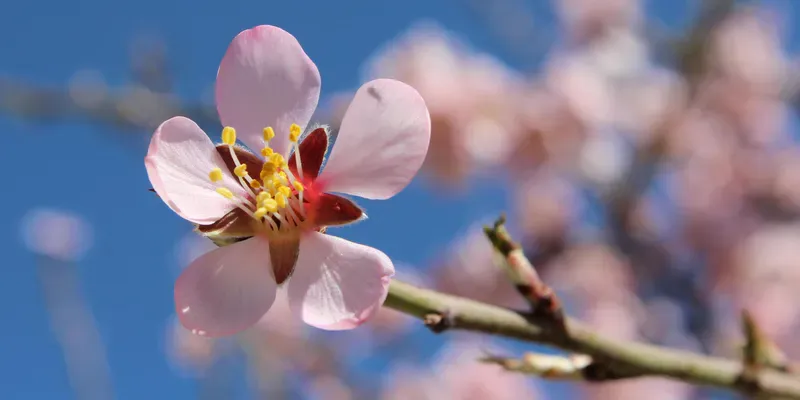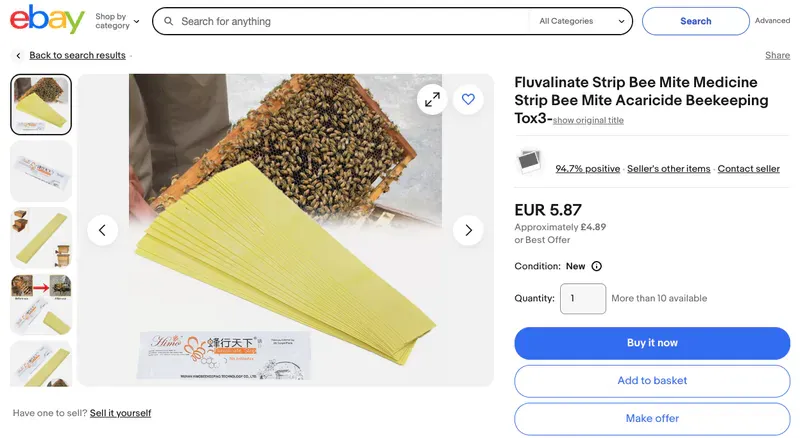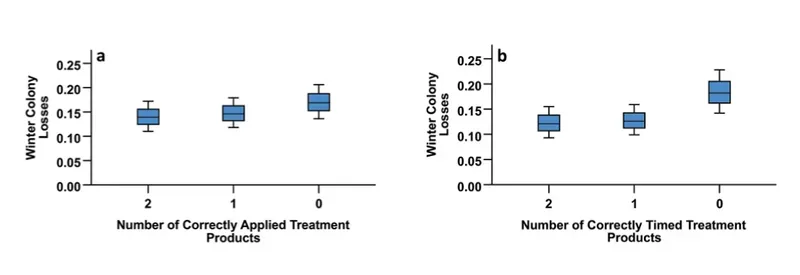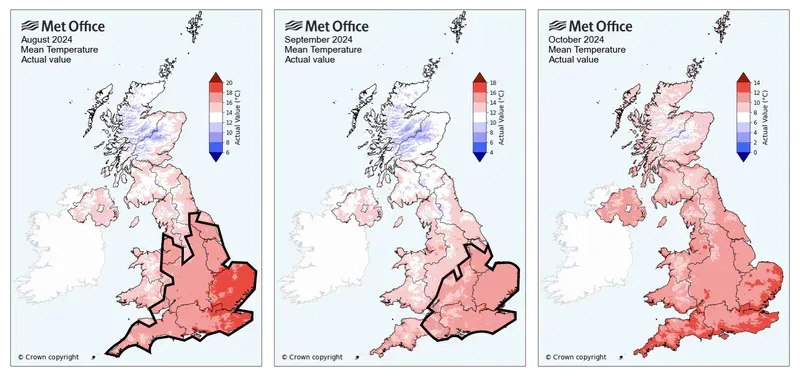Surveys and losses

Two interesting surveys came to my attention recently, one from either side of the Atlantic, so there's something for the majority of readers of The Apiarist in this post.
One of these surveys is on the type and timing of miticide usage in the UK — or, more accurately, in England and Wales — and the other reports some very high winter colony losses from the USA.
However, before discussing the results, I'll start by making the assumption that the underlying data in the surveys is accurate, unbiased, and complete, and that it would stand up to independent verification if applied.
These are big assumptions, particularly since regular readers will be aware that I tend to be a little sceptical of beekeeper or beekeeping surveys.
If I had treated my colonies with unbranded, imported miticide strips, I'd either not respond to the survey, or I'd be 'economical with the actualité' and my answer would describe the use of an equivalent licensed medicine such as Apistan.

My response might also be influenced by who was conducting the survey.
How likely would I be to admit to losing 90% of my colonies after treating with the strips in the image above (that appear to be administered by pushing them through the hive entrance 😞) if the person posing the questions was someone official, like the APHA or the VMD?
An extreme example?
Perhaps … so what about the beekeeper who asked me during a recent seminar whether treatment by repeated weekly application of vaporised oxalic acid was likely to harm their colonies?
The answer of course is 'no' (vaporised OA is very well tolerated) … with the caveat that only licensed Api-Bioxal should be used (not a generic product), and that Api-Bioxal is only approved for a single application by vaporisation per year {{1}}.
How would, or should they respond?
Perhaps I'm naturally cynical, or maybe I'm 'judging others by my own standards'.
Just to be clear, I wasn't asked, but would have been happy to answer 😄.
Anyway, let's assume the survey data is valid.
Treatment adherence and outcomes
The survey review (O'Shea-Weller et al., 2025) is Open Access, so you can read all tortuously-presented statistics with mug of tea {{2}} in front of the fire.
The National Bee Unit host a geographic database of UK beekeepers, imaginatively called BeeBase. Currently, there are ~45,000 beekeepers registered, who benefit from — amongst other things — email warnings of notifiable diseases (such as foul broods) within range of their apiaries. 5% of BeeBase registrants are (or were, none of the data in the paper post-dates 2020) randomly asked to complete a Husbandry Survey each year.
After applying some sensible 'sanity checks' e.g. ensuring professional beekeepers were not overrepresented, those using more than two miticides, the authors were left with a dataset containing ~4,300 beekeepers and ~19,000 colony/months, covering 2016-2020 from much of England and Wales. If my understanding is correct, these numbers of beekeepers and colony/months must be the total over the 5-year period.
Scotland was not included. This is disappointing as there was an association between winter temperatures and colony losses, and the inclusion of data from north of the border — where seasons are shorter and temperatures are lower — might have added significance.
Follow the instructions
There are some oddities in the 'classification' of the miticides considered. For example, VarroMed is indicated as recommended for use in December/January, but is advertised as a three-season product and — more importantly — approved as such. However, this is 'nit-picking' as most of this granularity is lost in the analysis because miticides were classified into 'summer' (April to September, inclusive) or 'winter' treatments, with losses considered within the same periods.
The key 'take home message' is that beekeepers who used approved miticides at the right time of the season lost fewer colonies or, as the authors put it:
Our results show that adherence to recommended Varroa treatment regimes is a prognostic predictor of overwinter colony survival.
Precisely 😉.
Beekeepers who did treat lost fewer colonies than those that did not treat and, of the range of miticides covered, those containing amitraz were associated with the lowest colony losses.

The timing of treatment was more important than the type of treatment. What's more, if the recommended application window was missed, it didn't really matter what was applied. It's not that they didn't work, it's just that none worked much better or worse than others if applied at the wrong time.
Here's an obvious example; Apivar strips cannot be used when honey supers are present. They are typically applied early or late in the beekeeping season, preventing the build-up of mites during colony expansion, or protecting the winter bees that are reared after the summer honey harvest, respectively.
I apply Apivar strips on the day I remove the summer honey supers, and leave them in place for 8–10 weeks.
Had I delayed the onset of treatment until mid/late autumn, the majority of the winter bees would have been reared in a colony with high levels of mites, so jeopardising their likelihood of successful overwintering.
Had I used Apistan, or Formic Pro, or Apiguard in late autumn instead, they also would not have worked to protect the winter bees … the damage would have already occurred.
Timing
The importance of appropriate timing of treatment application is something I've stressed previously. In addition to the appropriate use of Apivar (above) I can think of two other typical examples.
Api-Bioxal is only effective against phoretic mites surfing around the colony on the bodies of adult bees. It cannot penetrate the wax cappings of brood cells, and so leaves any mites associated with developing pupae disappointingly unharmed. It's therefore unsurprising that the instructions for Api-Bioxal make it clear that it is important that the colony is either broodless, or has the minimum level of brood. If not, mites will escape the miticide; not through resistance {{3}}, but simply through lack of exposure, and will continue to reproduce and damage developing brood.
In this instance correct timing means application to a broodless colony.
Apiguard contains thymol, and it needs to be widely distributed within the colony to effectively control mites. This requires an active colony which, in turn, means the temperatures must not be too low. I've discussed the relationship between temperature and efficacy previously (and commented on the contradictions in the advice from the manufacturers).
Documents provided by the manufacturer state:
The manufacturer recommends use of the product when the mean daily temperature varies between a minimum of 15 °C and a maximum of 40 °C.

This figure highlights the approximate areas in the UK where the mean temperature exceeded 15 °C from August to October (2024 data, but easy to check in previous years). If you're outside those areas, or you used Apiguard anywhere in October, then treatment is likely to have been suboptimal.
In the case of Apiguard, the correct timing is not broodlessness, it's defined by the ambient temperature.
I found the majority of the results unsurprising. I've written extensively about Varroa control and have — reasonably consistently — stated that the timing of treatment is more important than the choice of treatment. But remember, the environmental conditions or state of the colony must be appropriate for the treatment chosen.
Non-adherence
However, the surprising result in this analysis, particularly considering the nature of the survey (see my earlier comments) and the potentially unrepresentative group of beekeepers who register on BeeBase {{4}}, was the high proportion who "engage(d) in at least some level of non-adherence".
More than one third of responders who made it through the sift into the analysis either treated with unapproved miticides, or used approved miticides in a manner that was not approved, prompting the final sentence of the abstract:
These findings suggest that Varroa treatment non-adherence is a substantial driver of large-scale colony mortality.
These conclusions mirror a previous (smaller) Swiss study where minor non-adherence was associated with a 10-fold increased risk of colony loss, and major non-adherence raised this to 25-fold (Hernandez et al., 2022).
The final discussion of the O'Shea-Weller survey includes brief consideration of a range of factors that might contribute to non-adherence; aversion to synthetic chemicals, fear of contaminating honey, inability to monitor/assess disease etc.
False economy
One of those factors is economic.
Approved miticides are expensive when you consider the chemicals that they contain. Api-Bioxal costs about £0.31 a gram bought in 'bulk' (350 g sachet), but the same outlay (£110) buys you a whopping 25 kg of generic oxalic acid.
However, remember that oxalic acid is now on the EPP 'poisons' list (where EPP is an abbreviation for 'explosive precursors and poisons') … you can still buy it, but an individual needs an EPP licence, photo ID etc.
And, although you might be able to buy it, you still can't use it, as it is not an approved miticide 😞.
But there are more constructive ways to think about the cost of miticides … think of them instead from a cost/benefit standpoint.
Is the outlay economically sensible in terms of fewer lost colonies and increased honey production? {{5}}
The review by O'Shea-Weller (2025) has some data that is relevant to this — see Figure 5 in the paper — where they analysed honey production vs. treatment type.
The results are 'noisy' (smaller sample size, greater between-colony variation) but amitraz-treated colonies produced ~50% more honey than untreated colonies.
Here are some numbers that emphasise why it is false economy not to treat:
- the average honey yield per colony in the UK is 10-15 kg {{6}},
- the combined annual cost of Apivar and Api-Bioxal per colony is about £7.50, which is (conveniently 😉) the same as a 340 g jar of honey before the shop markup,
- simplistically, every colony lost through disease is therefore worth £275 😞.
Note the qualifying term simplistically; there are obviously lots of other factors to take into account.
However, 10-15 kg of honey per colony is on the low side of what should be achievable in many seasons. 2024 was a very average spring in Scotland and my colonies all managed 10-15 kg. In contrast, the summer was a nectar bonanza, and they averaged an additional 34 kg. According to my simplistic calculations, colonies lost to disease in the 2023 winter would have been 'worth' about £1,000.
'Do the math!' as they say.
'Nationwide and severe' US colony losses
The last paragraphs outlined the 'small beer' economics of miticide costs for amateur beekeepers. I'll now change tack completely and consider a recent report from Project Apis m. about 'big money' overwintering colony losses in the US.
A tweet appeared on social media linked to a PDF report entitled 'Severe and Sudden Losses of Managed Honey Bees Across the Nation'.
Urgent: Widespread Colony Losses Beekeepers across the U.S. report 50%+ colony losses, threatening pollination & food security. Information below to resources & survey
— Project Apis m. (@ProjectApism) February 6, 2025
Download info: https://t.co/UvAnUCNVQv
Beekeepers: Complete the survey by Feb 10: https://t.co/0he6Y7GQD0 pic.twitter.com/KgnUx5vx9V
The report, containing information from Project Apis m., the American Beekeeping Federation, the American Honey Producers Association and Adee Honey Farms is — unsurprisingly, considering the last three links — about large scale commercial bee farming in the USA.
Strangely, I can't find the linked report on the websites of those stated as providing the information within it, though the report — together with a more or less informed range of comments — appear on their Facebook page.
Briefly the report states that the 234 beekeepers surveyed reported losses 'well over 50%', with a projected financial loss exceeding $139M (remember that some of these operations are massive … Adee Honey Farms manage 80,000 hives, though it's not clear whether they are experiencing losses).
Together with other losses, Project Apis m. claims that the survey responders 'could be experiencing annual losses of 70-100%'.
Although the number of beekeepers is small, their colony numbers are far greater than if they were amateur beekeepers (though absolute numbers are not stated).
Is this representative across the entire US bee farming industry? Time will tell, and part of the reason for the announcement is to encourage other beekeepers to engage with the survey and testing of colonies.
There may be other reasons as well, who knows?
However, there's quite a bit of 'rounding up' going on, with 'over 50%' quickly jumping to 70-100% because of unspecified 'other losses'.
It's worth noting that annual surveys from the — now defunct — Bee Informed Partnership regularly reported 30-40% losses (Bruckner et al., 2023).
Is this something to be concerned about, or a case of 'Henny Penny'?
CCD redux?
Project Apis m. (yes, the trailing m. is part of the name) claim that "winter management and high levels of parasitic mites" appear not to be responsible for the losses, but instead report symptoms resembling colony collapse disorder (CCD).
CCD remains a poorly understood phenomenon from 2007/8 where bees abandoned hives, often leaving behind stores and small amounts of brood. Despite a large research effort, a definitive cause for CCD was never determined, though everything from pesticides, to viruses, or lousy beekeeping to mobile phone masts seemed to have been implicated at one time or another.
The first almonds in California will probably now be flowering. Their pollination — largely by honey bees imported from all around the US — has been described as possibly the largest single agricultural event in the world.

There are 1.4 million acres of almonds in California, and about 2.5 million hives are transported there to provide the necessary 'pollination services'. The crop is worth almost $4bn annually.
With so little information it's not possible to know whether this recent report represents the first announcement of the end of commercial bee farming in the US, or just another disappointingly poor winter with unacceptably high — but perhaps not unmanageably high because they'll make up (most/all of) the numbers during the coming season — colony losses.
Beemageddon?
We've been here before.
I've already mentioned CCD, and beekeepers in Florida {{7}} were reported to have lost 'up to 90%' of their colonies in late 2023 (by the same authors on this Project Apis m. report).
Was it mites? Perhaps it was a virus never seen before in honey bees? Was it neonicotinoids?
The sampling, pathogen analysis and economic impact of the Florida losses have largely been completed (Lamas et al., 2024), but the conclusions were disappointing:
The causes of these bee losses are still unknown.
My best guess?
Mites.
However, not just mites … these large-scale losses are largely in commercial beekeeping operations. The management of these colonies, their feeding, transport etc. bear little relationship to artisan, amateur, backyard, or hobbyist beekeeping.
I suspect it's 'death by a thousand cuts' … stress from repeated moves, poor nutrition, pathogens, more moves, more HFCS (Sammataro & Weiss, 2013), more stress and more pathogens. Small increases in the damage caused by just a few of these factors could be sufficient to kill off a colony and leave a 'corpse' that would confound even the best forensic scientist looking for an obvious cause of death.
If hobbyist beekeepers start reporting 90% colony losses I'll be worried.
However, losses by amateur beekeepers are higher than they should be and — to return to the first of the two surveys I've covered — can be minimised by the timely application of approved miticides, used according to the manufacturers instructions.
That those instructions are often rather poorly written, self-contradictory or out of sync with the scientific evidence is a topic I've covered before, and will return to again.
Ho-hum …
Why not sponsor The Apiarist?
The Apiarist appears weekly. Some posts, like this one, are freely available, others are restricted to subscribers, and an increasing number are only available to sponsors. Sponsorship costs less than a 175 g sachet of Api-Bioxal per year, helps offset the publication costs associated with sending thousands of newsletters a month, and the significant time I invest in the writing and research.
Go on … you know it makes sense 😉.
Coffee, as always, fuels my writing and is always welcome.
Notes
Any comments about oxalic acid/Api-Bioxal relate to the current regulations in the UK. Where you live it might not be on the explosive precursors and poisons list … and rhubarb leaves might not be considered a weapon of mass destruction.
Next week
The brood nest and hive inspections (at least, that's the current plan … if Beemageddon turns out to be real I might have to think again). The post next week will be for sponsors of The Apiarist.
References
Bruckner, S., Wilson, M., Aurell, D., Rennich, K., vanEngelsdorp, D., Steinhauer, N., and Williams, G.R. (2023) A national survey of managed honey bee colony losses in the USA: results from the Bee Informed Partnership for 2017–18, 2018–19, and 2019–20. Journal of Apicultural Research 62: 429–443 https://www.tandfonline.com/doi/full/10.1080/00218839.2022.2158586.
Hernandez, J., Hattendorf, J., Aebi, A., and Dietemann, V. (2022) Compliance with recommended Varroa destructor treatment regimens improves the survival of honey bee colonies over winter. Research in Veterinary Science 144: 1–10 https://www.sciencedirect.com/science/article/pii/S0034528821003696.
Lamas, Z.S., Chen, Y., and Evans, J.D. (2024) Case Report: Emerging Losses of Managed Honey Bee Colonies. Biology 13: 117 https://www.mdpi.com/2079-7737/13/2/117.
O’Shea-Wheller, T.A., Hall, A., Stainton, K., Tomkies, V., Budge, G.E., Wilkins, S., and Jones, B. (2025) A large-scale study of Varroa destructor treatment adherence in apiculture. Entomologia Generalis https://www.schweizerbart.de/papers/entomologia/detail/prepub/106352/A_large_scale_study_of_Varroa_destructor_treatment?af=crossref.
Sammataro, D., and Weiss, M. (2013) Comparison of productivity of colonies of honey bees, Apis mellifera, supplemented with sucrose or high fructose corn syrup. Journal of Insect Science 13: 19 https://doi.org/10.1673/031.013.1901.
{{1}}: Whereas a solution can be used for trickle treatment no more than twice per year. Weird, when you consider that oxalic acid-containing solutions damage open brood, whereas vaporisation does not. Remember the caveats … I'm in the UK and local rules where you are may be different.
{{2}}: A very large glass of wine might be more appropriate.
{{3}}: There's no evidence for resistance to oxalic acid, and it is unlikely to develop due to its mechanism of action.
{{4}}: My presumption being that beekeepers who engage/register with BeeBase are likely to be those who belong to a local/national association, and are more likely to read the documentation and/or read around a subject.
{{5}}: Clearly this is only appropriate if you sell honey, though you could substitute 'pleasure from your bees' — or wax/propolis/royal jelly production — in place of honey sales.
{{6}}: BBKA stats, that I cannot currently locate!
{{7}}: And subsequently in other States, but these were not analysed in the paper I cite.
Join the discussion ...